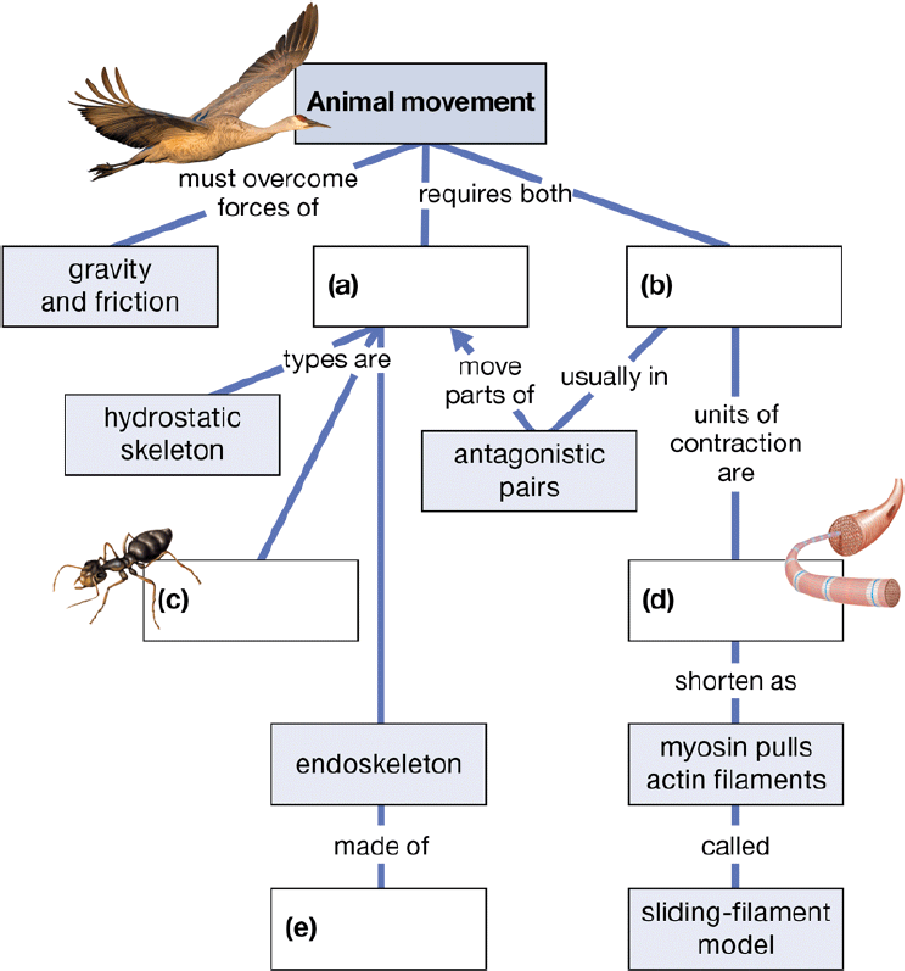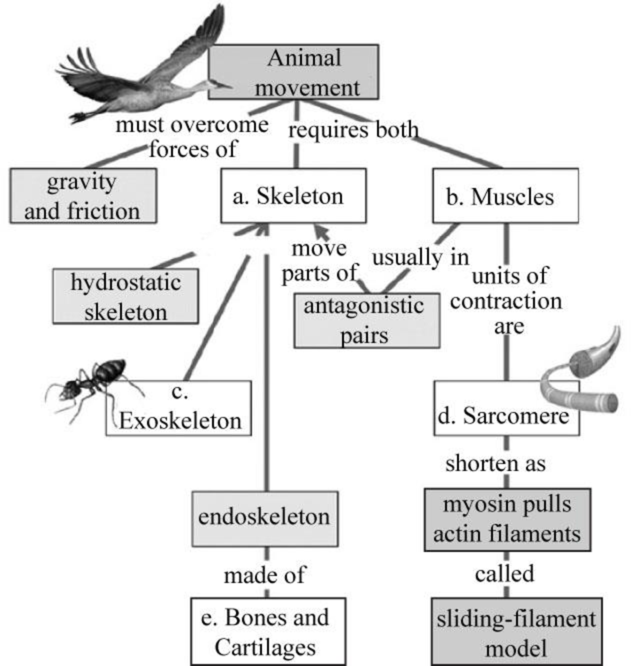
Concept explainers
Complete this concept map on animal movement.

To complete: The given map showing the animal movement.
Introduction:
Movement is a distinguishing characteristic of animals. Even animals that are attached to a substrate move their body parts. All types of animal movement have underlying similarities. At the cellular level, every form of movement involves protein strands moving against one another, an energy-consuming process.
Explanation of Solution
Pictorial representation:
Fig. 1 shows the completed map of the animal movement.

Fig. 1: Completed map of the animal movement
(a)
Correct answer: Skeleton.
Movement in animals requires both the skeleton as well as the muscle. There are many types of skeletons present among the various organisms, which include the endoskeleton, exoskeleton, and hydrostatic skeleton. Each skeleton is associated with different types of movement, such as, flying, walking, running, crawling, and others. Hence, the correct answer is skeleton.
(b)
Correct answer: Muscles.
In every organism, muscles are required to generate a required amount of energy, whether walking, running, swimming, or flying. Hence, the correct answer is muscles.
(c)
Correct answer: Exoskeleton.
The skeletons found among the diverse group of organisms are categorized into three types, which include the endoskeleton, hydrostatic skeleton, and exoskeleton. The exoskeleton is primarily found in the insects. Hence, the correct answer is exoskeleton.
(d)
Correct answer: Sarcomere.
Sarcomeres are the units of muscle contraction; they are found in the striated muscles and are present between 2-Z lines as a repeating unit. Hence, the correct answer is sarcomere.
(e)
Correct answer: Bones and Cartilages.
Endoskeletons are present inside the body and made up of bones and cartilages. Usually, all the vertebrates have a skeleton type as an endoskeleton. Hence, the correct answer is bones and cartilages.
Want to see more full solutions like this?
Chapter 30 Solutions
CAMPBEL BIOLOGY:CONCEPTS & CONNECTIONS
- explain why a person bringing 50 kg sack of rice will not move in the same speed and duration as one running in a marathon based on the concept of skeletal muscle contractionarrow_forwardWhy would skeletal muscle be unsuitable for the wall of the urinary bladder? Explain how this illustrates the complementarity of form and function at a cellular and molecular level.arrow_forwardDescribe an everyday activity not involving the arms inwhich your muscles would switch from isometric to isotonic contraction.arrow_forward
- In what ways does the neural control of smooth muscle activity differ from that of skeletal muscle? Describe how a stimulus may lead to the contraction of a smooth muscle cell without a change in the plasma membrane potential. Describe the differences between single-unit and multiunit smooth muscles. cite your referencesarrow_forwardIn the process of muscle contraction, which of the following steps requires hydrolysis of ATP to complete? movement of myosin head, pulling the thin filament binding of myosin head to active site on actin resetting of the myosin head back to its ready position letting go of myosin head from the active site on actin sliding of tropomyosin causing exposure of actinarrow_forwardExplain the concept of the following in regard to muscle cells: sliding filament movement does not need to be a super indepth answerarrow_forward
- An unexpected discovery from studies of ameboid movement is that the same proteins found in the contractile system of animal muscle—actin and myosin—are present in ameboid cells. Explain how these and other proteins interact during ameboid movement.arrow_forwardYou know from experience that skeletal muscle tires quite quickly, especially if there is not enough oxygen. Interestingly, shellfish such as clams can maintain a month-long contraction in the muscle that keeps the shell closed. No oxygen gets in this situation. These muscles have a different version of myosin called paramyosin. Knowing what you know about the cellular mechanism of muscle contraction, propose a hypothesis to explain how paramyosin might work.arrow_forwardMuscle Physiology Some skeletal muscle fibers are “fast-twitch” fibers (white fibers), and others are “slow-twitch” (red) fibers. Would you expect an athlete proficient in running the 100-yard dash to have a greater proportion of red fibers or white fibers in muscles of the leg? Why? Define the following: Maximal stimulus Threshold stimulus Submaximal stimulus A skeletal muscle can be stimulated, under laboratory conditions, with a supramaximal stimulus. Is it possible for the muscle to respond with a supramaximal contraction? Explain Define a motor unit. Of what physiological advantage is a small motor unit arrangement in skeletal muscle? Explain why a latent period is observed between the application of a stimulus and contraction of the stimulated muscle. Explain, giving two causative factors, why skeletal muscle displays fatigue. Does complete or incomplete tetanus occur physiologically? Explain. Define the following: Isometric contraction Isotonic contraction Optimum length…arrow_forward
- Fill in the blanks: In the contraction of the insect sarcomere, Cat+ binds with ____ causing it to change shape and remove _____from the actin reactive site. Myosin heads then bind with the reactive site, bend inward, release and reattach in a repeating cycle referred to as _____. The neurotransmitter released at the neuromuscular junction of insects is called ____ This neurotransmitter binds with receptors in the _____of the muscle fiber, which causes an electrical response that is carried deep into the fiber by invaginations called the _____. Each muscle unit of an insect is Innervated by a ____, which causes powerful rapid contractions, a slow axon, which causes slower, weaker contractions, and an inhibitory neuron, which releases the neurotransmitter ____.arrow_forwardMuscle spindle structures consist of: Extrafusal muscle fibers and gamma motor neurons Extrafusal muscle fibers and alpha motor neurons Golgi tendon organs and gamma motor neurons Intrafusal muscle fibers and gamma motor neuronsarrow_forwardIn the process of muscle contraction, which of the following steps immediately precedes the sliding of tropomyosin causing exposure of actin? binding of acetylcholine to its receptor binding of calcium to troponin exocytosis of acetylcholine at NMJ binding of myosin head to actin's active site binding of ATP to the myosin headarrow_forward
 Human Physiology: From Cells to Systems (MindTap ...BiologyISBN:9781285866932Author:Lauralee SherwoodPublisher:Cengage Learning
Human Physiology: From Cells to Systems (MindTap ...BiologyISBN:9781285866932Author:Lauralee SherwoodPublisher:Cengage Learning Biology: The Dynamic Science (MindTap Course List)BiologyISBN:9781305389892Author:Peter J. Russell, Paul E. Hertz, Beverly McMillanPublisher:Cengage Learning
Biology: The Dynamic Science (MindTap Course List)BiologyISBN:9781305389892Author:Peter J. Russell, Paul E. Hertz, Beverly McMillanPublisher:Cengage Learning

